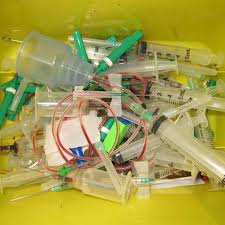Clinical waste generated within a hospital environment is disposed of in a number of different ways depending on whether it is:
- Infectious waste
- Visibly contaminated waste
- Anatomical waste
- Clinical sharps*
*Clinical sharps are explored on the next page.
Orange bag for waste from patients who are deemed to be infectious (i.e. they are on antibiotic or antiseptic therapy, or in isolation because of suspected infection)
- Aprons
- Autoclaved laboratory waste
- Bed pan liners

- Catheters
- Catheters suction
- Drainage bags – empty
- Dressings
- Gloves
- Incontinence pads
- Intravenous bags – fully discharged
- Intravenous giving sets (if attached to a fully discharged intravenous bag)
- Nappies (baby)
- Sanitary pad
- Sputum pots, disposable
- Wipes (soiled baby wipes, incontinence wipes)
- Vomit bowls disposable and empty
- Urinals, disposable and empty
- Stoma bags
Tiger bag for visibly contaminated waste
- Aprons
- Bed pan liners
- Catheters
- Catheters suction
- Drainage bags – empty
- Dressings
- Gloves
- Incontinence pads
- Intravenous bags – fully discharged
- Intravenous giving sets (if attached to a fully discharged intravenous bag)
- Nappies (baby)
- Sanitary pad
- Sputum pots, disposable
- Stoma bags
- Urinals, disposable & empty
- Vomit bowls disposable & empty
- Wipes (soiled baby wipes, incontinence wipes)
Clinical waste generated within a hospital environment is disposed of in a number of different ways depending on whether it is:
- Infectious waste
- Visibly contaminated waste
- Anatomical waste
- Clinical sharps*
*Clinical sharps are explored on the next page.
Yellow bag – waste for incineration
- Anatomical waste from theatres
- Diagnostic specimens
- Regent or test vials
- Kit containing chemicals
- Human tissue
